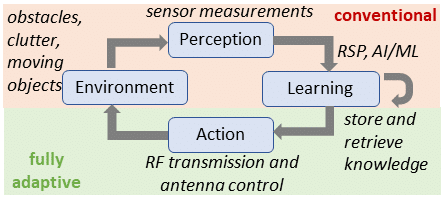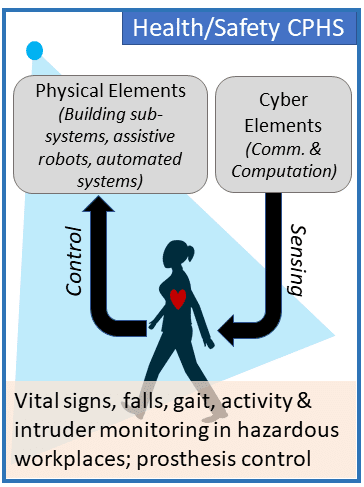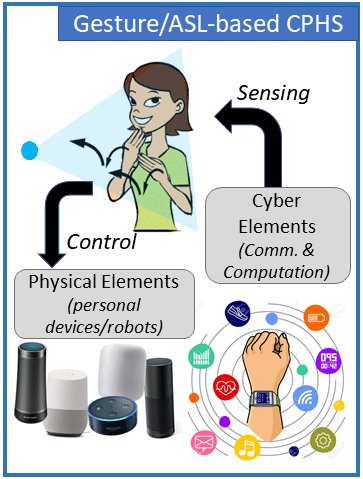Research
I am still in the process of rebuilding my website after changing institutions in Jan. 2025. Please check back here later.
RF-Enabled Cyber-Physical Human Systems for Remote Health Monitoring
RF sensing can be used to recognize human activities, analyze gait, detect falls, and assess fall risk, as well as monitor vital signs and sleep quality. CPHS in homes, assisted living facilities, and the workplace can enable early warning, post-treatment monitoring, as well as emergency response. RF-CPHS can save lives by triggering the aid of a robotic assistant or drone bringing medical supplies. Radar-embedded assistive devices can be used in rehabilitation or improve control of prosthetics. In automated factories, which may have hazardous areas, RF-CPHS can provide safety alerts and control equipment based on human presence and activity, as well as detect unauthorized users. My research aims to advance personalized radar-based AI/ML to advance remote health monitoring methods that will improve quality-of-care, reduce health care costs, and provide greater accessibility to healthcare in rural communities.
Radar-based Gesture and Sign Language Recognition
Gestures are a universal form of communication is a broad class of hand/arm movements for signalling, which also encompasses motions for controlling user interfaces (e.g. virtual knobs and sliders). Beyond gesturing, sign language is a highly expressive spatio-temporal language involving facial expressions, hand shapes and movement that is used worldwide by millions of Deaf/Hard-of-Hearing (HoH) individuals. My research aims to develop accessible human-computer interfaces controllable via gestures and sign language as an alternative to voice-recognition systems. Our pioneering work on radar-based American Sign Language (ASL) recognition for CPHS was supported via NSF CPS Award #1932547 and has resulted in the award of a 2022 U.S. Patent.

AFOSR Dynamic Data-Driven Information Processing (DDDIP) #FA9550-22-1-0384
NSF CPS CAREER #2238653
Physics-Aware Machine Learning for Radar Signal Analysis and Automatic Target Recognition
Radar data is not inherently acquired as an image and is instead a time-varying complex data series upon which radar signal processing techniques can be applied to generate 2D, 3D, and 4D data representations. The signal observed and RF data representations is strongly related to principles of electromagnetic backscatter and target kinematics. Thus, robust, pervasive, and accurate radar-based sensing requires the development of novel deep neural network architectures tailored for RF datasets. In this context, physics-aware ML is foundational paradigm for achieving this goal by integrating physics-based models with data-driven deep learning (DL) to reap the benefits of both approaches. Physics-based models allow for the prediction of the expected radar return given any sensor position, observation angle and environmental scene. However, no model is perfect and the dynamic nature of the sensing environment ensures that there will always be some part of the signal that is unknown, which can be modeled as noise, bias or error uncertainty. Physics-aware machine learning combines the strengths of DL and physics-based modeling to optimize trade-offs between prior versus new knowledge, models vs. data, uncertainty, complexity, and computation time, for greater accuracy and robustness. My research develops novel physics-aware machine learning approaches specifically for RF datasets, providing improved methods for synthesizing RF training data, designing physics-aware generative adversarial networks, and developing deep neural network-based classification methods.

AFOSR Dynamic Data-Driven Information Processing (DDDIP) #FA9550-22-1-0384
NSF CPS CAREER #2238653
Cognitive, Fully-Adaptive Radar for RF-CPHS
A cognitive or fully-adaptive radar is defined as “a radar system that in some sense displays intelligence, adapting its operation and its processing in response to a changing environment and target scene. In comparison to adaptive radar, cognitive radar learns to adapt operating parameters as well as processing parameters and may do so over extended time periods.” (IEEE Standards 686). My work aims to achieve this vision to optimize the design of more robust, effective AI/ML-enabled RF sensing for RF-CPHS. This involves not only developing effective ways of determining optimal RF transmissions, but also developing AI/ML algorithms that maintain high performance despite adaptation of the TX waveform: transmitting a different signal results in a shift in distribution that must be taken into consideration when designing AI/ML models for cognitive radars. My work aims to address these design challenges and thereby contribute to the advancement of cognitive target recognition, characterization and understanding methods, especially for the case of human motion analysis.
AFOSR Dynamic Data-Driven Information Processing (DDDIP) #FA9550-22-1-0384
Radar-based Unmanned Aerial Vehicle Detection and Recognition
Office of Naval Research (ONR)

